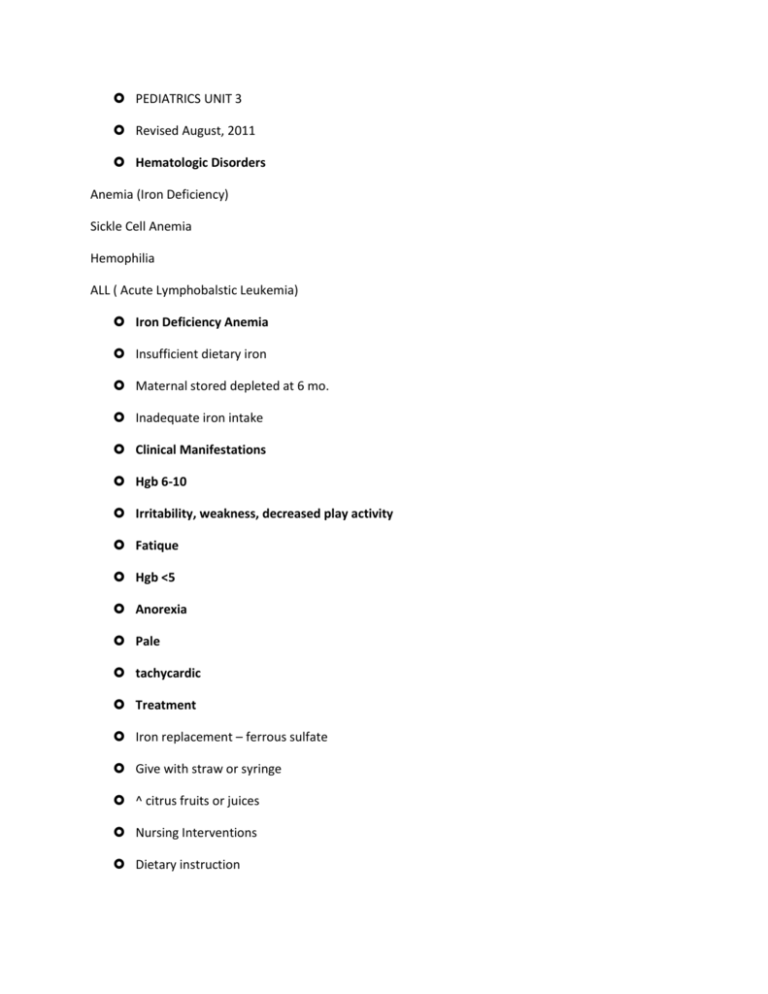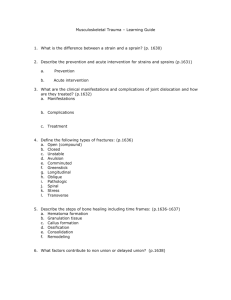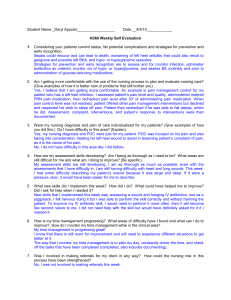PEDIATRICS UNIT 3 Revised August, 2011 Hematologic Disorders
advertisement

PEDIATRICS UNIT 3 Revised August, 2011 Hematologic Disorders Anemia (Iron Deficiency) Sickle Cell Anemia Hemophilia ALL ( Acute Lymphobalstic Leukemia) Iron Deficiency Anemia Insufficient dietary iron Maternal stored depleted at 6 mo. Inadequate iron intake Clinical Manifestations Hgb 6-10 Irritability, weakness, decreased play activity Fatique Hgb <5 Anorexia Pale tachycardic Treatment Iron replacement – ferrous sulfate Give with straw or syringe ^ citrus fruits or juices Nursing Interventions Dietary instruction Teaching of long term complications of anemia Dark, tarry stools Sickle Cell Anemia Inherited African-American / Mediteranian No cure Sickling: Clumping of abnormal shaped cells Results in obstruction w/ severe tissue hypoxia Sickle shaped cell in center of picture Severe sickling can lead to sickle cell crisis, an acutely painful period that occurs intermittent throughout life. Factors that precipitate a crisis Infection Dehydration Cold Emotional stress Nursing Interventions Hydration Analgesics O2 Warm baths, local heat Avoid precipitating factors Coagulation Disorder Hemophilia Inherited – X linked Lack clotting factors: Factor VIII or Factor IX Clinical Manifestations: Bleeding, bruising Hemarthrosis Bone deformities, contractures Hematomas Diag test: PTT Medical Management: Replace clotting factors CRITICAL THINKING Q’S What are your nrsg interventions? What is RICE? What are s/s of intracranial bleed? Neoplastic Disorder Acute Lymphoblastic Leukemia Most commom malignancy in children, ^ males Increased blast cells Decreased rbc’s and platelets Internal organs enlarge Medical Management: Chemo & steroids Intrathecal drugs Goal is remission Clinical Manifestations Pallor, fatigue Fever, ^ infections Bleeding, bone pain Limping s/s of ICP Nursing Interventions: Monitor s/s infection & reduce risk Oral care Enc. Nutrition Immune Disorders AIDS RHEUMATOID ARTHRITIS HIV/AIDS Chronic, usually fatal Perinatal infection, 91% Blood & bodily fluids Sexual abuse Adolescents have ^ risk d/t risky behaviors Medical Managment Keep viral load low Prev. infections Restore normal G & D Improve quality of life Box 31-2 drugs Nursing Interventions Prevent infection Nutrition / meds Family support Juvenile Rheumatoid Arthritis Chronic inflammatory autoimmune connective tissue disease Destroys cartilage, affects joints & tissues Occuring bet. 1-3 & 8-10 yrs old Clinical Manifestations Stiffness, edema Loss of motion Warm to touch Increase temp Macula rash Diagnostic Tests Clinical findings No specific tests ESR X-rays Medical Management Preserve joint function NSAIDS – SAARDS Moist heat - PT Nursing Interventions Manage pain, educate Support groups to express fears & concerns Balance rest/exercise Respiratory Disorders Acute respiratory infections are common in infancts & children. They range from minor to life threatening illnesses. Respiratory Distress Syndrome Lack surfactant to keep lungs expanded Gestational age at birth influences severity #1 s/s respiratory distress Treatment Exogenous Surfactant O2 therapy Parenteral therapy Pneumonia Inflammation of lung tissue Common cause RSV Viral more common than bacterial Clinical Manifestations See Box 31-3 Dx x-ray Tx O2, fluids, nebulizers, antx if bacterial cause Nursing Interventions Resp & CV assessmt Infection control Hydration, IV fluids O2 & antx as ordered Sudden Infant Death Syndrome No cause Occurs during sleep 3rd leading cau of death betw. 2-4 mos. Diagnosed on autopsy Nursing Inteventions Family grief support Allay feelings of guilt and blame Teach “back to sleep” Acute Pharyngitis “sore throat” 80% viral 20% strep H-influenza in children , 3 yrs s/s: Fever Sore throat White exudate Tonsillitis S/S same as pharyngitis Treatment : 1)Same as pharyngitis 2) Tonsillectomy Nursing Care Pre-op Notify MD of temp Post-op Monitor for bleeding, no straws, analgesics Post-op: Semi prone Monitor for bleeding Analgesics No straws Croup Acute viral disease marked by resonant barking cough, difficult breathing & laryngeal spasm. Laryngeotracheobronchitis LTB = most common form of Croup Follows an URI s/s: barking cough, tachypnea retractions Epiglottitis Cause: H influenzae bacteria Life threatening airway obstruction Signs & Symptoms Drooling High Fever Resp distress Muffled voice Progressive resp. distress Anxiety Fear Nursing Assessment Check for the 4 “D’s” 1) Drooling 2) Dyspnea 3) Dysphonia 4) Dysphagia Treatment Maintain airway Cool mist NPO – IV fluids Epinephrine, Antx Nursing Interventions ^ HOB Assess resp. status Freq. VS Trach tray @ bedside Bronchitis Usually viral s/s: same as with URI + cough Common during winter months Children < 4 y.o. Cystic Fibrosis Inherited, defective gene No cure Excessive thick mucus produced Obstructs lungs & GI system Clinical Manifestations steatorrhea Barrel chest Increased NaCl in sweat & saliva Nursing Interventions ^ nutrition Pancreatic enzymes CPT / postural drainage Asthma Common chronic childhood illness Obstructive resp. disorder, familial tendency Figure 31-12 Signs & Symptoms Bronchospasm Bronchial edema s/s: SOB Expiratory wheeze Medical Management Quick relief meds Long term meds Allergen testing Nursing Interventions ^HOB Meds, hydration Rest, breathing exercises Avoid triggers Teach self-care GASTROINTESTINAL DISORDERS Any alteration in GI function has the potential to affect other bodily systems. Cle Cleft lip & Cleft Palate Facial malformation during fetal development Assoc. w/ folic acid deficiency, ETOH & smoking Figure 31-14, B Figure 31-14, C Figure 31-14, D Clinical Manifestations Cleft lip little feeding diff. Extensive cleft lip & palate dif. Feeding & speech Surgical Management Lip repaired at 1-2 mo. Palate repaired by 1 yr. Multidisciplinary hlth care approach Nursing Interventions Parental support Assistive feeding devices ESSR feeding techniques Freq. burping Post Op Care Maintain integrity of suture line Adv. Diet as tol Soft rubber tipped feeder, no breast Back or side lying only Dehydration Intake less then output Determined by change in wt. Infants and young children more easily effected Diarrhea & Gastroenteritis o Treatment Treat cause Restore fluids and electrolytes Modified BRAT diet, Pedialyte, Rehydralyte, Infalyte Nursing Interventions I&O Infection control Nutrition, rehydrate Daily weights Constipation Passage of hard infrequent stool Structural disorders Diet, meds Repressed urge to defecate Hypertrophic Pyloric Stenosis Hypertrophied pyloric muscle obstructs gastric outlet Unknown etiology Fig. 31-16 pg. 1022 Increased frequency, fluid content & volume of stools Figure 31-16 Signs & Symptoms Projectile vomiting Olive shaped mass, R. abd Wt loss, poor skin turgor dehydration Surgical Treatment Pyloromyotomy ( Fredet-Ranstedt procedure) Intussusception One part of intestine telescopes into another S/S currant – jelly like stool Abd. pain Diagnostic Test: Barium enema Tx: barium enema Surgical repair Hirschsprung's disease Presents as Megacolon Hirschsprung's disease is a condition that affects the large intestine (colon) and causes problems with passing stool. It's present when a baby is born (congenital) and results from missing nerve cells in the muscles of a portion of the baby's colon. Megacolon Figure 31-18 Two Stage Surgical Treatment Temporary colostomy Endo-rectal pull through Nursing Interventions: Pre-Op Care?? Post-Op Care ?? Hernia Organ protrudes through weakened muscle wall Figure 31-19 Appendicitis Inflammation of appendix s/s rebound tenderness Elevated WBC Pain @ McBurneys point Gastroesophageal Reflux Regurgitation of gastric contents Vomiting/spitting up/choking/gagging Esophageal ulceration Heme. + stool Medical Management Small frequent thickened feedings Pepcid, Zantac, Tagamet Surgical repair Genitourinary Disorders Disorders of the GU Syst. alter the delicate balance of fluid & electrolytes in the body and may be life threatening Nephrosis or Nephrotic Syndrome Proteinuria Edema Hypoproteinemia hyperlipidemia Signs & Symptoms Peri-orbital edema Ascites Generalized edema Nrsg. Interventions I&O Skin care ^pro. diet Acute Glomerulonephritis Inflammation of glomerulus Strep is most common cause s/sproteinuria tea colored urine HTN ( idiopathic ) Nursing Interventions Bedrest Restrict fluids & Na + I&O Diuretics and antihypertensive Wilms Tumor = Nephroblastoma Most common malignant tumor of childhood Develops from immature kidney cells Prognosis greatly improved in recent decades Signs & Symptoms Large, firm, asymptomatic abd mass Do not palpate abd Nrsg. Interventions Pre/post op care Family support Surgery Nephrectomy Endocrine Disorders Disorders are usually from over or under production of hormones. Can affect all aspects of body function including appearance, G & D and psychologic well being. Hypothyroidism = Cretinism Lack thyroid hormones Tx. Thyroid hormone replacement Nrsg. Interventions: Teach parents importance of med administration to prevent cognitive & growth impairment Diabetes Mellitus Type I Diabetes (IDDM) Lack of insulin TXexogenous insulin, diet & exercise Nrsg Interventions Family teaching is paramount What topics would be included in your teaching?





